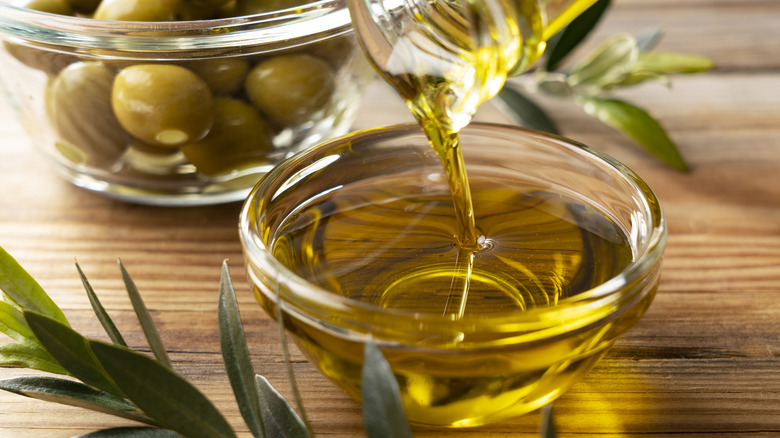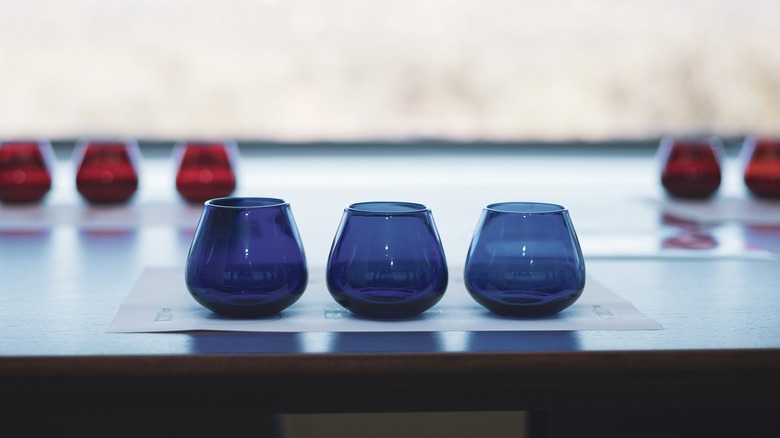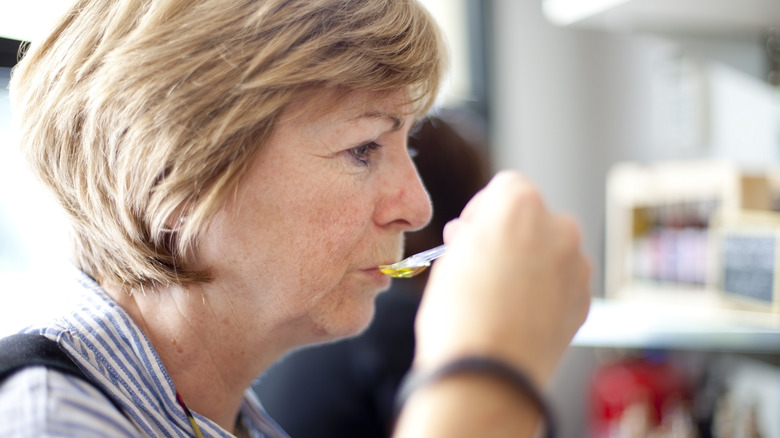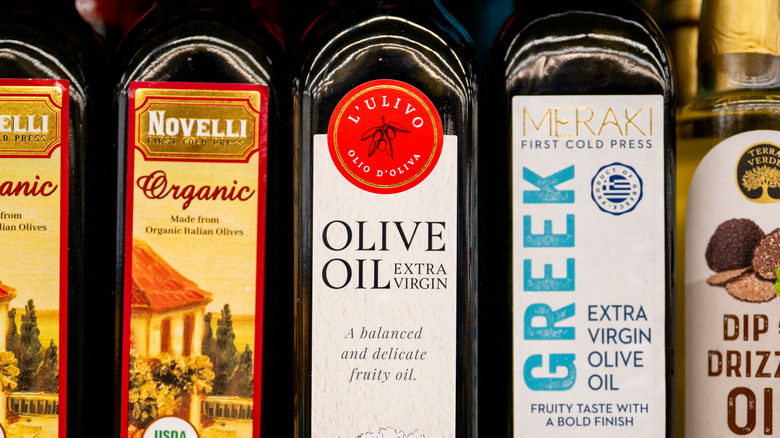How Professionals Taste-Test Olive Oil
Since olive oil is often the backbone behind our favorite savory dishes, choosing a quality oil is essential. Before you pick a new variety, however, you have to know how to properly evaluate it. As professional olive oil taster David Neuman shared on "The Kelly Clarkson Show" in 2022, olive oil is the only food that must be tasted before its label can be validated. So, if you're curious, here's how the professionals taste-test it.
First, oleologists recommend you taste olive oil by itself rather than on a cracker or piece of bread to hone in on its distinctive flavors. As established oil taster Nicholas Coleman shared with Serious Eats, "At official tastings, we use opaque, blue stemless glasses. The color of the glass keeps tasters from being influenced by the color of the oil. The glass' shape is meant to fit perfectly in the palm of a hand, so we can warm the oil and release its aromas." Olive oil's color doesn't reflect its quality, but light negatively impacts it, which is why you should buy olive oil in tins rather than glass bottles.
Even if you don't have the ideal tasting glasses at home, you should still swirl and warm your oil with your hands before tasting. Try putting a loose cap over the vessel to trap all of its concentrated aromas. Now, it's time to smell the oil for its distinctive aromatics.
After smelling olive oil, it's finally time to taste
As expert Alexis Kerner shared with Olive Oil Lovers, when smelling oil, it's important to mind the specifics. Is the smell ripe like a vegetable or green like a plant? Intense or mild? Is it fresh, or does it harbor something unseemly, like a fermented or moldy smell? Once you've made these deductions, it's time to taste. Slurp it like you would wine at a tasting, allowing it to properly coat your mouth so you can fully understand its flavors. Is it spicy, bitter, or sweet? Once you've reached a verdict, rather than spit out the oil, swallow it — this last step is super important.
Different dishes require different olive oils, and to really understand your oil's character, swallowing it is key. This is how you determine the strength of its flavor, as those peppery notes will appear best in the back of your throat. (This is also why it's best to keep a glass of water nearby during an oil tasting.) Notes that are especially peppery mean the oil is full of antioxidants, which would make it a better fit for dishes in which you want its flavor to really shine through. For meals that simply use the oil as a fatty element, however, you might want to find a more mild, versatile option.
Factors to consider during the tasting process
Like many other parts of life, what specifically to look for in an olive oil's taste is an abstract question, as it all depends on personal preference. Does your dish require a refined or extra virgin olive oil? What flavors do you personally prefer? These are the questions you should be asking yourself as you taste.
Generally speaking, oleologists look for a few of the same things during every oil tasting. Are there any unpleasant, rancid tastes? These might result from improper handling of olives before the pressing process. Next, professionals like to hone in on an olive oil's exact flavors and scents, from notes of fresh green apples and tomatoes to bitter cut grass and almonds. From there, you can decipher what flavors in a meal would best pair with the oil. Expert Alexis Kerner shared with Olive Oil Lovers that tasters often take a bite of green apple in between samples to cleanse their palates.
Other components of olive oil to keep in mind
Beyond taste, you can decipher a lot about an olive oil by considering some of its other components. As Nicholas Coleman shared with Serious Eats, just like with a bottle of wine, you can tell a lot about a bottle of olive oil by looking at its harvest and bottling dates. You'll want to choose an oil made from a recent harvest, which will vary depending on the region. "In the northern hemisphere, olives are harvested in the fall. In Tuscany, harvest begins somewhere at the end of October and continues into November," Coleman said.
Additionally, Coleman claimed that where an olive oil comes from and what varieties of olives were used are also important considerations. You should look not just at the country where an oil comes from, but at the specific region. "Oils of dubious origin will sometimes say 'Product of Italy' on their labels. They might be a blend of oils from all over the world, simply bottled and shipped out of Italy. Good olive oils nearly always state the specific region they were produced in," Coleman shared.
So, there are more than a few ways to determine if an olive oil is good or not. Still, if you want to know more, check out our ultimate guide to buying olive oil for more ideas.



